At Access Rehabilitation Equipment, we commit to providing you and your loved ones solutions for life! Fitting your lifestyle, each aid and equipment is tailored to the unique challenges you are facing, so work with us to find the independence and mobility you want!
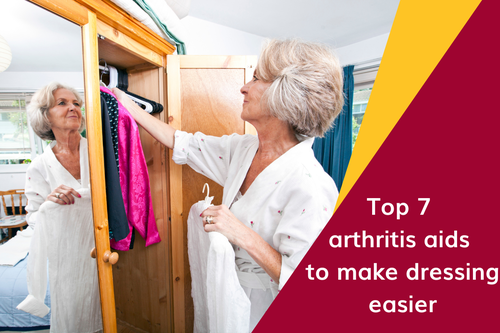
For individuals with arthritis and limited mobility, the simple act of putting on clothes can be a constant source of frustration. While it’s an easy aspect of daily routine for many, when debilitating conditions like arthritis or another rheumatic disease are thrown into the mix, this uncomplicated task becomes more challenging. Imagine getting dressed while dealing with pain, swelling, stiffness, restricted range of motion, joining deformities, and weakness – it’s no wonder this everyday task can feel like a taxing and emotionally draining chore, taking a toll on both physical and emotional well-being.
Luckily, there are arthritis aids available that can help individuals with arthritis to dress themselves. In this article, we will cover some invaluable tools and tips that enable arthritis patients to achieve greater independence in their dressing routine.
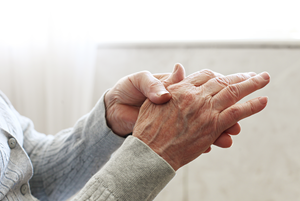
Why is getting dressed difficult with arthritis?
Dressing or undressing requires dexterity and finger strength, which can be difficult for individuals experiencing arthritis in their small hand joints. It also involves maintaining balance and maneuvering the body, which can be challenging for those with arthritis in their larger joints, like the knees and hips.
Arthritis usually begins by affecting the smaller joints, specifically those that connect your fingers to your hands and your toes to your feet. That's why handling snaps, small buttons, and hooks can be hard to perform, particularly during the morning when pain and stiffness are often worse.
How do you get dressed easily with arthritis?
Getting dressed with arthritis doesn’t have to be a struggle. With some of these practical tips, dressing yourself is about to become a whole lot easier.
-
Choose clothing that’s easy to put on and off.
Choose garments with larger openings, like elastic waistbands or pull-on pants, to reduce the need for intricate fastenings. When shopping for clothes in the future, consider opting for pull-on tops and tunics rather than button-down blouses, choose sweatshirts with zippers over tight-fitting turtlenecks, and joggers and pants with drawstring waistbands instead of skinny jeans and snug-fitting slacks.
-
Prepare ahead.
To ease arthritis's morning stiffness, pick out your outfit the night before. Iron your clothes and lay them out flat for easy morning dressing. Pre-tie necklaces or scarves so you can effortlessly slip them on over your head.
-
Get dressed while seated for better balance.
For those with arthritis, maintaining balance while putting pants or shoes on can be difficult due to stiff joints. To avoid the risk of losing balance or stumbling, it is best to sit down while getting dressed. If you have a room, keep a bench or chair in or near your closet to make it easier to sit while you get dressed.
-
Take your time.
With arthritis, everything can become more time-consuming and demanding. Giving yourself enough time to get dressed can help prevent the added frustration from rushing. Rushing yourself through the process can lead to sudden, jarring movements that intensify joint pain.
Allocating enough time also reduces stress, which can be particularly detrimental when dealing with arthritis, as stress can aggravate physical and emotional symptoms.
-
Warm up your joints.
Morning stiffness is a prevalent symptom in various forms of arthritis. Swelling and immobility overnight can lead to discomfort and rigidity in your joint upon awakening. If you can adjust your morning routine, try waking up a little earlier to stretch and move before engaging in activities that might be interfered with by joint pain, such as styling your hair, applying makeup, or preparing breakfast.
Start your day with gentle movements like bed stretches or a short morning walk. Even soaking in a warm shower or bath can aid in loosening up your joints.
-
Consider using assistive tools for arthritis hands
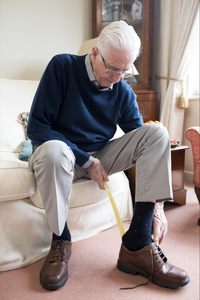
Assistive tools are not just canes and walking sticks. Mobility aids also include items, like shoe horns or button hooks that can make it far easier to fasten your clothing or dress independently. Using these arthritis tools may feel awkward at first, but with practice, they make life and getting dressed a lot easier.
-
Ask for help.

Although dressing aids, devices, and strategies are available to assist you with getting dressed, there will be times when you just need help. Whether it's fastening buttons, zipping up pants, or reaching for clothing items, seeking a helping hand from a loved one or caregiver can significantly simplify the process.
What should I wear for arthritis?
If you are looking for ways to update your wardrobe and make it more comfortable for your arthritis, here are some tips on what to wear:
- Loose-fitting clothes: Opt for loose-fitting garments that don’t constrict your movement and are easy to put on and take off, such as jogger sweatpants or Palazzo pants. This type of clothing is easier to slip into, especially during arthritis flare-ups.
- Elastic waistbands: Drawstring waistbands are a comfortable choice. If you prefer jeans, consider the more relaxed boyfriend fit, which avoids the struggle of pulling them over your calves and thighs.
- Front-closure bras or sports bras: If you have arthritis in your hands or shoulders, front-closure bras can be easier to manage than traditional back-hook bras.
- Replace your laces: For those with arthritis, tying up laces is no easy task. Save your finger and switch to elastic shoelaces. Velcro closures and slip-on shoes are also fantastic alternatives.
- Seamless socks: Seamless socks prevent irritation and discomfort, especially if you have sensitive skin or joint inflammation.
- Adaptive clothing: Consider adaptive clothing designed specifically for individuals with limited mobility or arthritis. These often feature easy closures and comfortable fabrics.
- Compression garments: Some people with arthritis find relief from compression garments, such as compression socks or gloves, which can reduce swelling and provide support.
- Button hooks and zipper pulls: Keep assistive devices like button hooks and zipper pulls handy to make managing buttons and zippers easier.
How do you pull up pants with arthritis?
Pulling up pants when you have arthritis can be quite challenging, but there are strategies that can make this task more manageable.
Sitting down on a stable surface, such as a chair or bed, can significantly reduce the strain on your joints. This provides a stable base from which you can work. Using a long shoehorn can also be helpful; insert it into the pant leg and use it to guide your foot through.
Another technique is rolling up your pants to ankle level, then sitting down and sliding your feet into the pant legs before gradually rolling the pants up. Opting for pants with front closures like Velcro or elastic waistbands can be a wise choice.
Top 7 arthritis aids to help with dressing:
Whether you need something to make those finicky buttons easier to close or a tool for effortlessly putting on socks, here some arthritis aids to help with dressing:
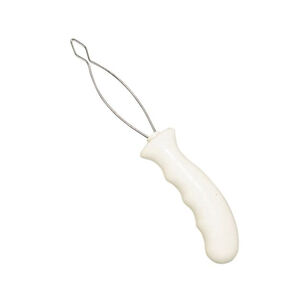
A button hook is an easy to use dressing aid that lets you secure buttons with one hand, especially the small ones that may be difficult to grasp. The hook design is simple and easy to use, making it a perfect solution for those with arthritis that impact dexterity. It typically features a wire loop that goes through the buttonhole and hooks around the button. With a gentle pull, the button is guided back through the buttonhole, effectively fastening it in place. It’s that simple!
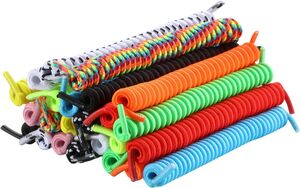
No-tie curly shoelaces are made from stretchy elastic material and designed in a spiral, so they will stay in place without tying. These innovative laces offer convenience for individuals with disabilities and arthritis who have trouble putting shoes on. The elastic material stretches with your foot’s movement, ensuring comfort during walking without pinching your foot. Additionally, it maintains sufficient tension to keep your shoes securely in place, preventing them from slipping off.
With elastic shoelaces, you simply need to tie your shoelaces once, which you may need someone to thread the laces into your shoes. This eliminates the need for repeated tying and the inconvenience of frequently bending down to put on or remove your shoes.
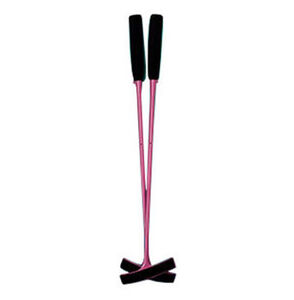
The Ezy Ups dressing aid is a pair of long sticks with handles and curved T-shaped ends designed to help people with arthritis who struggle to get dressed. This dressing aid can be used to assist with putting on underpants (disposable and standard), trousers, pants or skirts by pulling them up to above knee height.
Using Ezy Ups to put on clothing just takes three steps: Place the two sticks into the clothes. Place over the feet. Then, pull clothing up over the legs until above the knees. Reversing these steps can help the removal of clothing, as well.
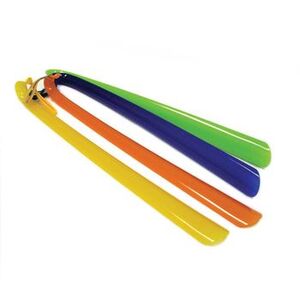
Putting on shoes requires bending, which can be less than ideal if you experience back pain or have limited flexibility, making it difficult to reach down to don shoes. A long-handled shoe horn offers a practical solution by providing extended reach while putting on footwear.
A typical shoe horn has an elongated design with a curved or spoon-shaped end, allowing you to slip it into the back of your shoe. With this dressing aid, you can effortlessly guide your foot into the shoe without strenuous bending or intricate hand maneuvers.
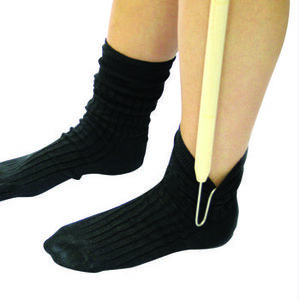
Dressing sticks are handy mobility aids, especially designed to provide assistance for individuals coping with arthritis. These adaptive tools extend your reach and dexterity to make dressing a far more manageable task. If you experience limited mobility, joint pain, or challenges with one arm, a dressing stick becomes your trusty companion. Designed to help you put on shirts, jackets, and pants easier, dressing sticks offer relief from pain when gripping clothing items with your fingers and thumbs.
Dressing sticks come in various sizes, materials, and widths. The hook may come in different forms, typically made from metal or plastic. Some models also include a built-in shoehorn to
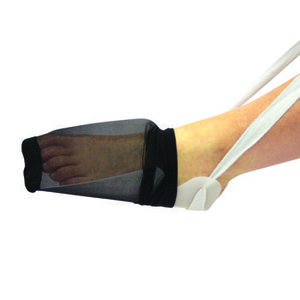
Sock aid can make putting on socks or stockings much safer and easier to manage. These low-cost dressing aids reduce the need to bend and reach down to put your socks and stocking on by pulling the socks into position on the foot/leg.
With a sock aid, you just simply slip your feet into the sock opening without having to stretch, bend, or reach!
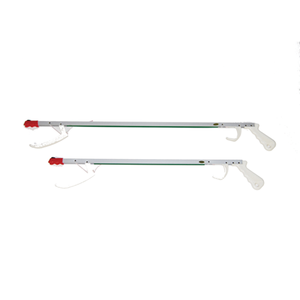
At times, the most challenging part of getting dressed can be reaching the clothing items in the first place. Whether to reach high shelves or avoid bending, long-handled reachers can be a versatile tool anyone with mobility issues would love. With its fitted post to assist with dressing, think of it as the third hand you’ve always wanted.
Especially designed to aid those with arthritis and limited mobility, long-handled reachers are extendable tools perfect for performing tasks around the house, reaching for items and helping you get dressed. The extended length of the reacher allows you to access clothing items, shoes, or other dressing essentials without the need to bend, stretch, or reach awkwardly.
These helpful arthritis tools address the unique needs of individuals with arthritis, offering practical solutions to make dressing a breeze. By incorporating these dressing aids into your daily routine, you can regain control over your wardrobe choices and start your day with confidence.
Conclusion
Living with arthritis presents unique challenges, but with the right arthritis aids, dressing can become a less frustrating and painful task. With these tips and tools, getting dressed can once again become a manageable and enjoyable part of your daily life.
Remember to consult with a healthcare professional or occupational therapist to determine which aids are best suited to your specific needs.


 Providing solutions for life
Providing solutions for life







